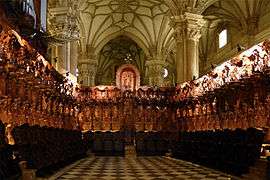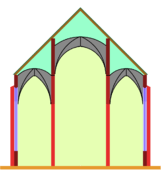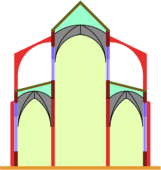Hall church
A hall church is a church with nave and side aisles of approximately equal height, often united under a single immense roof. The term was first coined in the mid-19th century by the pioneering German art historian Wilhelm Lübke.[1]
In contrast to a traditional basilica, which lets in light through a clerestory in the upper part of the nave, a hall church is lit through windowed side walls typically spanning the full height of the interior.
This form of church construction has a long history (for example Bishop Meinwerk's Bartholomäuskapelle at Paderborn which was consecrated c.1017) but reached its height in the late Gothic period, especially in German Sondergotik, and most notably in the areas of Westphalia and upper Saxony. The design also found favour in the Angevin lands of western France (for example, Poitiers Cathedral) and a notable example in Bristol Cathedral, England. Elsewhere, one also finds the hall-church design adapted to smaller-scale projects such as chapels or retrochoirs (e.g. Salisbury Cathedral, Temple Church, London)
Some Gothic Revival churches imitate the hall church model, particularly those following German architectural precedents. One example of a neo-Gothic hall church is St. Francis de Sales Church in Saint Louis, Missouri, designed by Viktor Klutho and completed in 1908.
-
Romanesque hall church St-Hilaire in Melle, Deux-Sèvres, western France
-
St-Lambert's in Münster, Westphalia
-
_(8419330818).jpg)
Munich Frauenkirche, a hall of three naves with lateral extensions
-
.jpg)
St-Wolfgang's in Schneeberg, Saxony
-

Twin-naved hall church of the Ensemble conventuel des Jacobins (fr.wiki) in Toulouse
-

Guadix Cathedral, in Andalusia, the southernmost medieval hall church
-
.jpg)
Manueline hall church of Jerónimos Monastery in Belém suburb of Lisbon
-
Wooden arches and wooden ceiling of St-Mary's in Usedom, Vorpommern
A completely separate 20th-century usage employs the term "hall church" to mean a multi-purpose building with moveable seats rather than pews and a chancel area which can be screened off, to allow use as a community centre during the week. This was particularly popular in Britain in inner city areas from the 1960s onwards.
Contrast: Church hall.
Principles and variations
Some typical forms of hall churches and how to distinguish them from basilicas:
-

Hall church. Instead of one longitudinal roof, it may have several roofs, either longitudinal or travers.
-

Stepped hall, the vaults of the central nave begin a bit higher than those of the lateral aisles, but it doesn't extend to an additional storey.
-

Pseudobasilica, the central nave extends to an additional storey, but it has no upper windows.
-

Basilica, the central nave extends to two storeys above the lateral aisles, called gallery and clerestory.
-

Hall church with arches but no vaults and a partly horizontal, partly sloping ceiling
Various floorplans of hall churches:
-

St-Mary-in-the-Marsh (de.wiki) in Soest, Germany, Westphalian square
-

St. Elizabeth's Church, Marburg, cross-shaped
-

Greyfriars Church (de.wiki), Berchtesgaden, Bavaria, two equal naves
Further information
Lists of almost all hall churches of Europe are available in fr.Wikipedia and de.Wikipedia. The listed churches are identical with the national lists in Czech, Dutch (for Netherlands and Belgium), Polish, Portuguese and Spanish Wikipedias.
References
- ↑ Wilhelm Lübke Die mittelalterliche Kunst in Westfalen (1853)
.jpg)